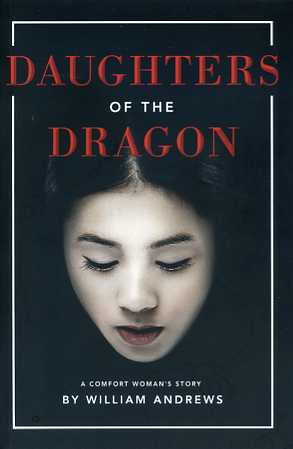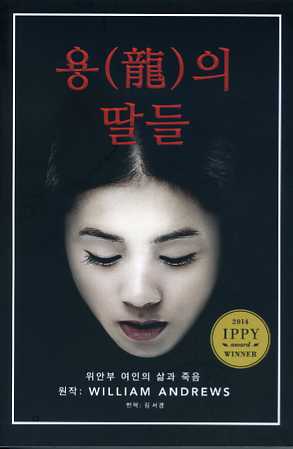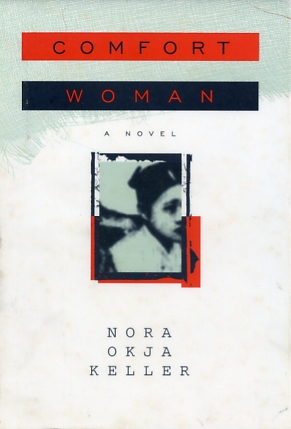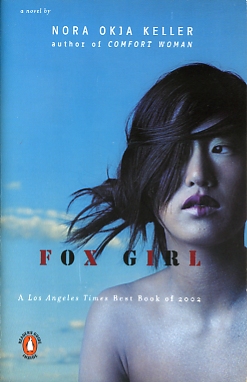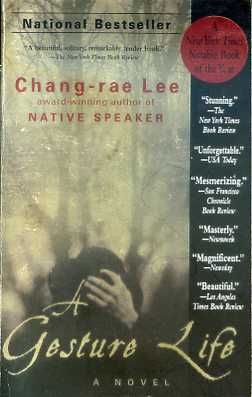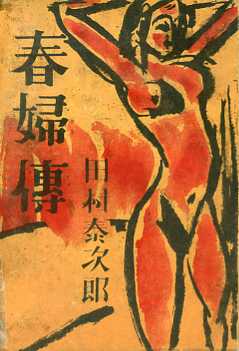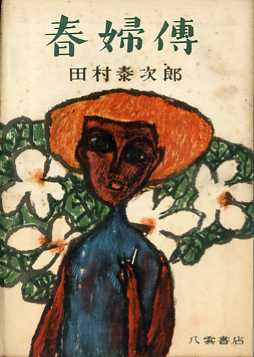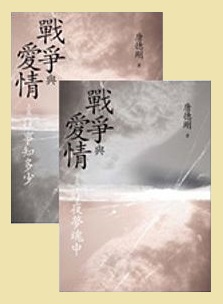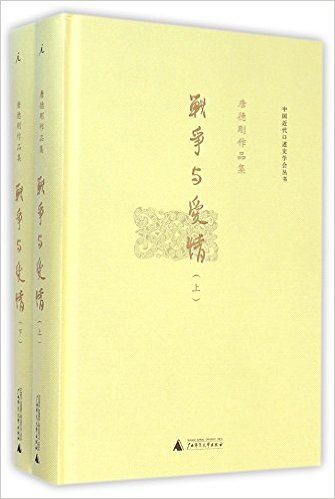Comfort women in popular fiction
Objects of praise, sympathy, pity, and fantasy
By William Wetherall
First posted 1 August 2015
Last updated 2 April 2017
Novels Andrews 2014 • Keller 1997 • Lee 1999 • Tamura 1947 • Tang 1985
NovelsQuite a few fictional works in English and Japanese feature so-called "comfort women" (ianfu Τΐw), some as protagonists. They vary in quality and ideological treatment. The titles shown here are just of a few of those I will eventually introduced here. Some authors have claimed that their story was based on actual experiences, which does necessarily make the stories truthful. They may be compared to popular and even academic histories that readers assume to be true, but which are full of falsehoods that have gained the status of truth in tabloid history. Tamura Taijirō's Shunpuden (1947), the earliest known and arguably the most truthful and realistic Japanese novel to feature Chosenese comfort women in China, was subject to censorship by GHQ/SCAP (General Headquarters, Supreme Commander for the Allied Powers) officials during the Allied Occupation of Japan. And all film versions have distorted the story, the first to avoid censorship during the Occupation, the remakes to avoid touching sensitive nerves among Japan's small but reactive populations of Chosenese and Koreans. Yosha Bunko and The Steamy EastThis page is associated with the "Comfort women" feature under the "Legacy issues" group in the "The Sovereign Empire" part of the "The Empires of Japan" feature under "History" on the Yosha Bunko website. I have also listed it on The Steamy East site because some of the stories, while marketed as "literature", have more the feel of "genre" fiction, with elements of mystery and intrigue and even sexual titilation. |
Andrews 2014William Andrews 원작FWilliam Andrews The back cover of the English edition reads as follows. DURING WORLD WAR II, THE JAPANESE FORCED 200,000 KOREAN WOMEN TO BE SEX SLAVES FOR THEIR SOLDIERS. THIS IS ONE WOMAN'S RIVETING STORY OF STRENGTH, COURAGE AND PROMISES KEPT. In 1943, the Japanese tear young Ja-hee and her sister from their peaceful family farm to be comfort women for the Imperial Army. Before they leave home, their mother gives them a magnificent antique comb with an ivory inlay of a two-headed dragon, saying it will protect them. The sisters suffer terribly at the hands of the Japanese, and by the end of the war, Ja-hee must flee while her sister lies dying. Ja-hee keeps her time as a comfort woman a secret while she struggles to rebuild her life. She meets a man in North Korea who shows her what true love is. But the communists take him away in the middle of the night, and she escapes to the South. There, she finally finds success as the country rebuilds after the Korean War. However when her terrible secret is revealed, she's thrown into poverty. In the depths of despair, she's tempted to sell the comb with the two-headed dragon that she believes has no magic for her. Then one day she discovers its true meaning and her surprising heredity. And now she must find the only person who can carry on the legacy of the two-headed dragon . . . someone she abandoned years ago. Set within the tumultuous backdrop of 20th century Korea, Daughters of the Dragon by Mayhaven Award-winning author William Andrews will make you cry and cheer for Ja-hee. And in the end, you'll have a better understanding of the Land of the Morning Calm. The actual storyThe story is really about an American named Anna -- a palindrome -- who was born in the Republic of Korea and when 5-months old was adopted by Htennek and Nasus Noslrac in America and had a dog named Ydnas. Anna Noslrac -- or Anna Carlson if you play her name game -- tells her story in her own voice. And it is essentially a juvenile adventure story, as Anna is only 20 -- not yet an adult under American law -- when she becomes curious enough about her her biological roots to pressure her father to take her back to Korea to pursue them. Unable to find out anything from the adoption agency, they are about to leave when an old woman approaches Anna and slips her an address she is urged to visit before she leaves. Anna's father is not excited about the idea but lets Anna go alone. The women turns out to be her grandmother and she wants Anna to have an heirloom that turns out to be coveted by others who want the dynastic powers it is said to represent. The reader knows that Anna -- like the heroes and heroines in all such stories -- will overcome all obstacles -- including her father's feelings that she should let others have the heirloom it to keep it would jeopardize her life, at at times even her own doubts about whether she should accept the political baggage that comes with her unexpected royal descent -- and prevail against all evil. The main reason to keep turning the pages is to learn how, when she boards the plane home, she will smuggle it out of the country. RESUME Nancy Drew Young Reader cut out gratuitous sex
|
|||||
Nora Okja Keller 1997Nora Okja Keller Nora Okja Keller Both novels presented here concern the plight of women whose circumstances led them to become prostitutes. Both involve racially-mixed protagonists in "Korea" and Hawaii, which are features they share with the author's biography. Nora Okja Keller was born 1965 in Seoul, the Republic of Korea, to a Korean woman and a German father. Keller is her husband's name. Keller was raised in Hawaii mainly by her mother, and after a college education in Hawaii and California, focusing on literature, she began working in Honolulu as a journalist. In 1995 she won a prize for a short story titled "Mother Tongue", which she incorporated in her first novel, Comfort Woman, which was published in 1997 and received the 1998 American Book Award in 1998. Keller reported in a number of interviews that Comfort Woman was inspired by Hwang Keum Ja (1925-2014), who according to YonHap News who "was forced to work at a glass factory at 13 and then sent to China to work as a sex slave at 16" according to an obituary. In Releasing the Story to the World: An Interview with Nora Okja Keller by Jocelyn Lieu, herself a writer, Okja reportedly said this about her inspiration to write Comfort Woman. The thing that drew me to write Comfort Woman in 1993 was a lecture I attended where a former comfort woman, Keum Ja Hwang spoke about her experiences as a young girl forced into a comfort camp where she was forced to sexually serve Japanese soldiers. That was the first time I had ever heard about that and I remember thinking, 'Why is this the first time I've ever heard about this? Why am I only hearing about it now? Why doesn't everyone hear about it? Why isn't it a part of our national consciousness of world history? The synopsis on the front flap of the jacket of my edition of Comfort Woman reads as follows. To be continued. |
Chang-rae Lee 1999Chang-rae Lee This second novel by Chang-rae Lee, following Native Speaker (1995), has become one of the celebrated fictional portraits of war-crime guilt on Asian American Studies reading lists at American colleges and universities. Lee, born in the Republic of Korea in 1965, came with his parents to the United States when he was three. He graduated from Yale University in English, and Native Speaker was his Master of Fine Arts thesis at the University of Oregon, where he then taught creative writing. He is now a professor of creative writing at Princeton University. A Gesture Life features Franklin Hata speaking directly to the reader as the novel's first-person protagonist. Everyone regards the retired medical and surgical supply store proprietor as a kind, thoughtful, intelligent, and sensitive Oriental man, and "Doctor Hata" enjoys "an almost Oriental generation as an elder" (Lee 1999: 1). Hata, presumably of Japanese descent, is haunted by his memories. And when one day his estranged adopted daughter Sunny contacts him, his quiet life begins to slowly disassemble. His closet door opens, and in it we see his birth in Korea, his service as a medic in the Imperial Japanese Army, his love for K, a Korean comfort women. Hata reveals his relationship with K through, of course, his own eyes, which are possibly delusional. K is the only comfort woman who seems to gaze at him as though she might like him. His unit commander, a doctor named Captain Ono, who is also fond of K, orders Hata to keep an eye on her to prevent her from killing herself. Hata's recollections are those of an ambiguous situation in which it is impossible to know whether K, who Hata describes as unemotional, has any true romantic feelings for either man, or submits to them merely because she is being kept in captivity and is merely protecting herself by not resisting. First-person "perpetrator"My impression from reading a lot of fiction involving a "perpetrator" and a "victim" is that most writers would have given this story's microphone to the comfort woman or her daughter. Apparently Lee himself began writing this story as a "comfort woman victim" rather than "peretrator guilt" story. In a Beatrice Interview with Ron Hogan in 2000, Lee acknowledges that giving Hata the novel's voice was an afterthought.
|
Tamura Taijirō 1947, 1949The life of a spring womanOne of the most important works of fiction -- which is arguably more factual as "social history" than most radical "sex slave" accounts of comfort women in China -- is Tamura Taijirō's Shunpuden, a novella he wrote in 1946 shortly after his repatriation from China. The story was slated to appear in the inagural issue of a new literary magazine in 1947, but censors at General Headquarters, Supreme Commander for the Allied Powers (GHQ/SCAP) suppressed the galleys, and the magazine was published without it. However, a month later a slighly reworded version was published in a collection of Tamura's stories, and this version -- with some minor changes -- continued to be published in various collections. See Tamura Taijiro's Shunpuden: The life of a Chosenese comfort woman in wartime China in the Literature section of Yosha Bunko for a summary of the story, publication particulars, scans of the covers of various editions, and translations of selected passages. |
||||
Tang Te-kang 1985War and LoveTong Te-kong (T'ang Te-kang, Tang Te-kang, Tang Degang 德 1920-2009) was born in Anhui in Hefei province as a national of the Republic of China during the transition from its 1st to 2nd republics. After Japan's invasion of China in 1937, Tong made his way to Chungking (Chongqing), where Chiang Kai-shek had set up his Nationalist government in exile. From 1939-1943 he studied history at National Central University in Chungking (dc§εw), and in 1948, during the civil war between Nationalists and Communists, he went to America to continue his studies and in 1959 he received a PhD in history from Columbia University. He later taught at Columbia University and at City University of New York (CUNY), became a US citizen, and died in San Francisco. 德 Tong Te-kong (T'ang Te-kang, Tang Degang) George Hicks on "War and Love"George Hicks describes the novel and its story as follows (Hicks 1995: 41-42). He does not cite any references that I can find and so it is anyone's guess as how he came up with his version of the story. The [bracketed remarks], highlighting, and boxed comments are mine.
Amazon.com synopsis of "War and Loves"Guangxi Normal University Press in Guilin, Guangxi province, posted the following description of the novel in its English publicity on Amazon.com.
Web tidbits on Tang Te-kangTang Te-kang authored many books about Nationalist China and its leaders. He lectured widely about the political history of China in the 20th century and its relationship with Japan. He also contributed to movements by people of Chinese descent in the United States to publicize the plight of Chinese victims of Japan's agressions in China. The following texts were cut and pasted from the Internet. From official Kuomintang website Chang Iris β The Rape of Nanking: The Forgotten Holocaust of World War II β |
